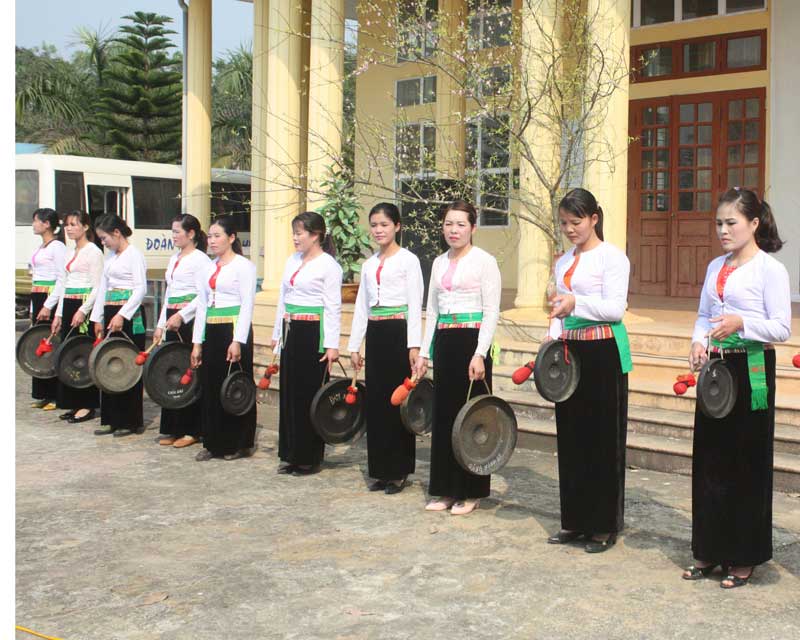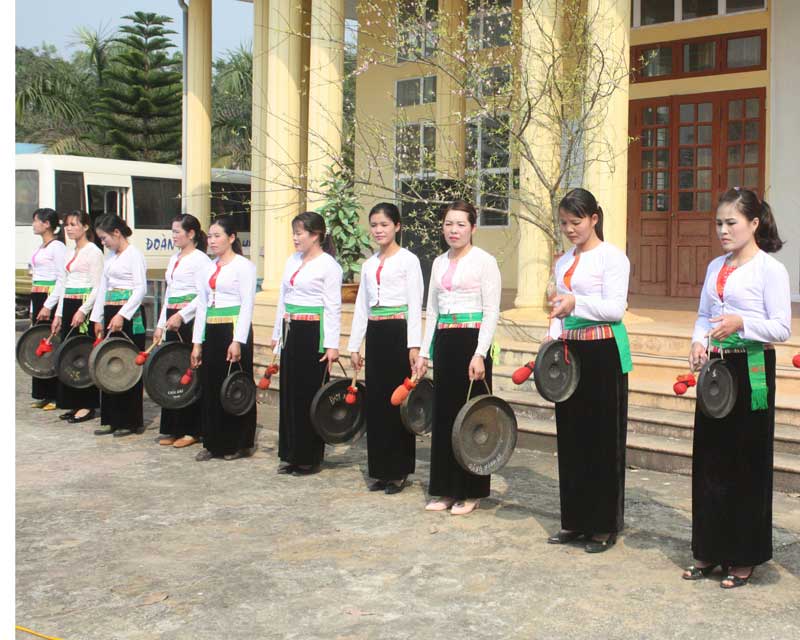



The Gong
team of Dung Phong commune (Cao Phong) practicing to perform at the opening
ceremony of Muong Thang festival.
According to the
opinions of people living here, the festival cannot be started without the Gong
ringing. The Gongs stepped out to the festival from each small family. Every
year, on the first ten days of January, the Gongs start ringing to inform the
opening of Muong Thang festival. The Gong set performed at the festival
includes 250 Gong players with many ancient traditional Gong songs, which
express the expectation in a year of happy life and abundant crops. In the past
time, Dung Phong commune has always taken care of preserving Muong Gongs by
some ways: teaching how to play Gongs to young people; preserving in having
Muong Gong festivals in all the traditional festivals, large events of the
localities. In the whole commune, there are about 400 gongs with many professional
players who usually participate in large festivals of the districts and
province.
In Cao Phong
district, many large festivals take place in a year, such as the opening of
Season Muong Thang, Den Bo festival, Khanh Pagoda festival, etc. All the small
and large festivals have the performance of Gongs. The Gongs resonation is
euphoric to start the festival and quiet to end the festival. On the 6thday of Lunar January, the people in Xuan Phong commune eagerly participate in
the festival of farming. According to the customs, the festival consists of two
parts: the ceremony and the festival. The ceremony part starts with the
procession of the Buddha from Mr. Khai’s house to Ru Temple (in Ru 6 village).
The procession is led by a Mo master, followed by a Gong set selecting
professional gong players, dressing in beautiful performance costumes. The Gong
sounds resonate through the mountains and spread in all the villages. The
echoes of the Gongs ringing are up and down, resounded to express the joyfulness
of a successful production year, all the houses are full of warm and the
villages are so peaceful.
Mr. Nguyen Hoang
Huy, the Vice Director of Cultural and Sports center of Cao Phong District
said: People of Muong Thang consider Gongs as their treasure. Gong is known as
flesh-and-blood, spirit and soul accumulated for over thousands of years. A
Gong set consists of 4,5,7,9 gongs. A complete set has 12 gongs, divided into 3
sets (dam gongs, bong gongs, tle gongs). In addition to its musical meanings,
gongs represent 12 months of a year. Muong gongs are familiar to the people
here since they were born; and to the community and traditional festivals of
Muong Thang, gong echoes cannot be missed at the beginning of the festival.
Muong ethnic people have conception that gongs also have their souls. Every
occasion at the beginning of the year, before the festival, Muong ethnic people
usually do rituals to wake up Gongs so that they won’t oversleep. Therefore,
the gong echoes can be sonorous and bring joy. The old people will have an
action of rubbing the knobs until the gongs make sounds louder and louder and
resonate.
In Cao Phong
district, every commune has a performance team of Muong Gong. After hard
working time, people will gather at the culture center of the village to
practice traditional gong songs. The elderly people teach the young people how
to beat the gongs. So the gong beating is passed to the next generations over
the time. Cao Phong District has a lot of Muong gong performances in large
festivals; then the number of gong players is up to hundreds. In the whole
district, there are about 20 gong teams, about 3,000 gongs with 20 players who
can play ancient gong songs. In which, Xuan Phong and Dung Phong are 2 communes
which has a greatest number of gongs with 800 ones.